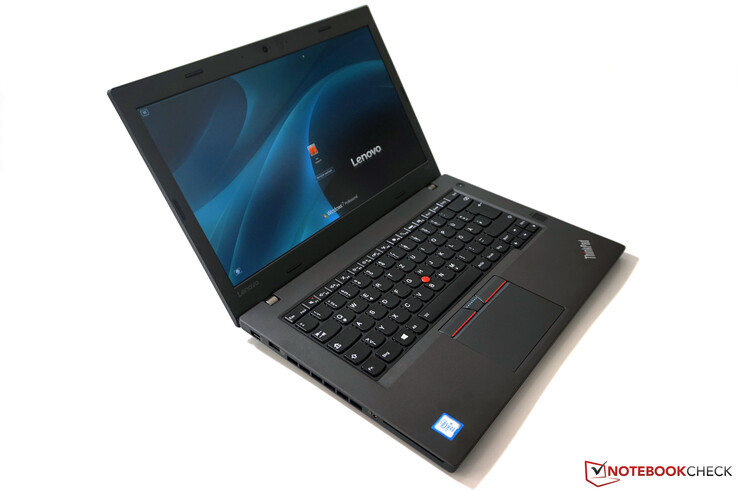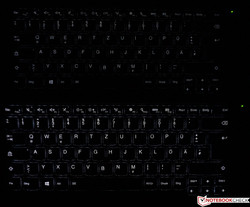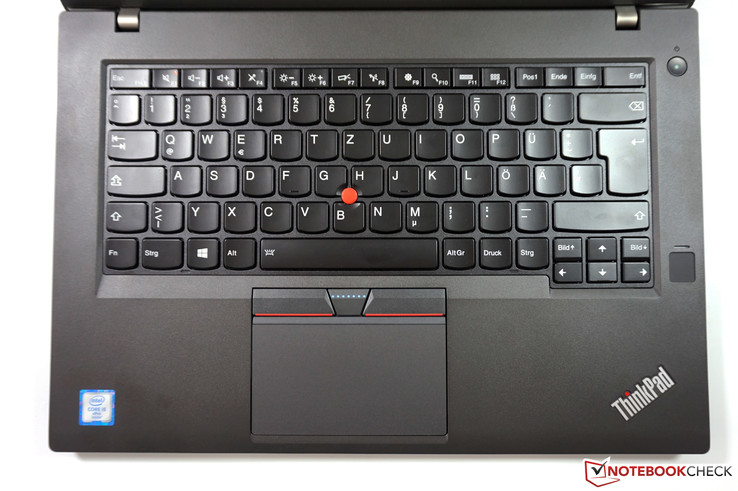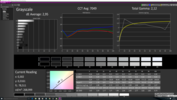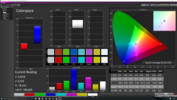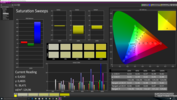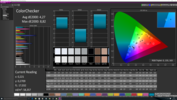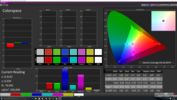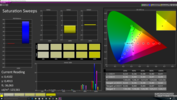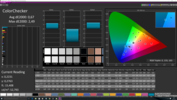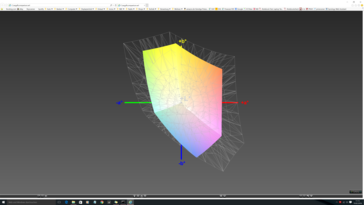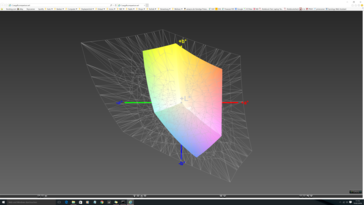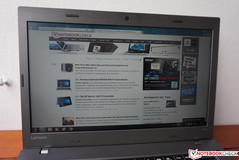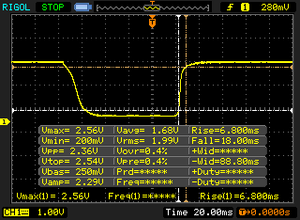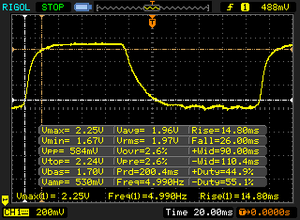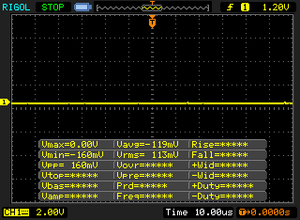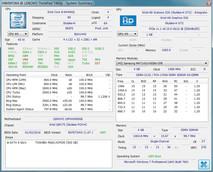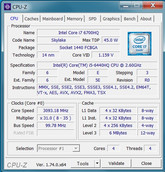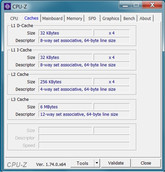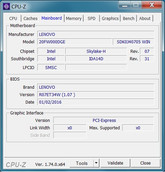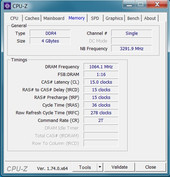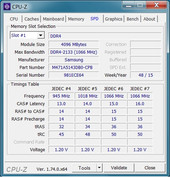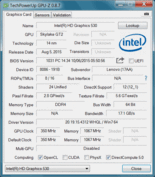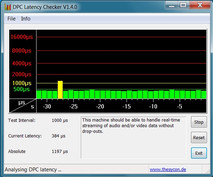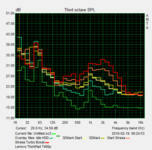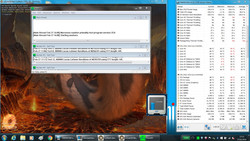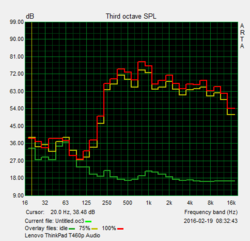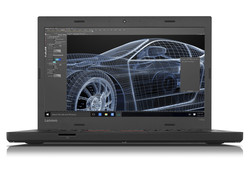Lenovo ThinkPad T460p Notebook Review

For the original German review, see here.
Since the introduction of the ThinkPad Tx40 generation, Lenovo has designed its premium office notebooks based on Ultrabook specifications, and therefore only uses frugal ULV processors and waives optical drives. The only exception was the ThinkPad T440p (here in review), which gets a direct successor with our review unit two generations later. The ThinkPad T460p is only available with fast mobile quad-core processors and could be a welcome alternative if you need more performance, but do not want to make the switch to mobile workstations from Lenovo’s own P-series or from another manufacturer.
The ThinkPad T460p is not currently listed in Lenovo’s online shop, but some models are already listed on familiar retailer sites. Our test model carries the designation ThinkPad T460p 20FW000DGE and is one of the smallest configurations with a retail price of around 1400 Euros (~$1557). You get an Intel Core i5-6440HQ processor, 4 GB of RAM, a 500 GB hard drive as well as a matte Full HD IPS display. The configuration is therefore pretty sparse except for the powerful processor, but you should not forget the important business and security features, which are crucial for the target group.
The biggest competitors for the T-series are traditionally from HP and Dell. We could not review the current models yet, so we use the EliteBook 840 G2 as well as the Latitude E7450 as comparison devices for this review. There are also interesting alternatives from Lenovo, like the normal ThinkPad T-series or the less expensive ThinkPad L-series. So far, we have only had the chance to review the current 15-inch model ThinkPad T560. It does not differ from the 14-inch model in terms of components and is therefore a good indicator of the performance difference between the ThinkPad T460 and T460p.
Case
Unlike its direct predecessor T440p that used a completely different chassis compared to its siblings, the T460p is a rather thicker version of the T460. The additional space is required to accommodate the faster processor, but you also have to forego an optical drive. With a thickness of 24.4 mm (~0.96 in; without battery), it is just 3 mm (~0.1 in) thicker than the current T460 (21 mm/~0.8 in), but noticeably slimmer than the old T440p at 3 cm (~1.2 in). With a weight of about 2kg (~4.4 lb/ including the 6-cell battery), the device is lighter and leaves a very compact impression. Because of the similarities to the T460 (which is based on the T450), we are dealing with a familiar case. The dark-gray plastic surfaces might appear rather boring, but they suit a business device. It is a glass-fibre reinforced compound, which combined with the magnesium construction produces a very sturdy base unit. Old weak spots, including the area above the SmartCard reader and above the keyboard, have been improved as well.
The thin lid is significantly weaker, which can be noticeably twisted even under low pressure. Pressure on the back will result in picture distortions and slight creaking noises. We can also see a build quality issue at the display, because there is a small gap between the lower edge of the frame and the panel. Although there should not be any functional restrictions, we would expect that a premium device does not show these kinds of issues. The metal hinges might look rather small, but have no problems with the light screen and can prevent bouncing even at bigger opening angles (more than 180 degrees possible). You should open the lid with two hands if possible; otherwise you will quickly lift the base unit.
The battery at the bottom can be accessed from the outside and replaced easily. Our 6-cell model raises the rear area of the device by around 1.5 cm (~0.6 in). We are already familiar with these larger batteries in Lenovo devices, but we are still rather surprised considering the "normal" capacity of 48 Wh. We are sure that there would have been a more elegant solution. There is no maintenance hatch at the bottom, so you have to remove the whole bottom cover to access the components. We will have a closer look at the topic in the Maintenance section.
Connectivity
The ThinkPad T460p covers all the basics in terms of ports, but you do not get very modern interfaces like Thunderbolt 3 or USB 3.1 (Type-C). The HDMI output is based on the standard 1.4b and can only transmit 4K signals at 30 Hz; the Mini-DisplayPort on the other hand at up to 60 Hz. A VGA output is not available anymore and has to be realized via an adapter if necessary. Almost all the ports are distributed across the sides, only the card reader is located at the front edge. We like the port layout in general, even though an additional USB port would not hurt (3x USB 3.0 available).
We were able to measure a maximum transfer rate of 314 MB/s at the USB 3.0 ports in combination with our external SSD. The SD-card reader only manages average results with our reference card (Toshiba Exceria Pro SDXC 64 GB UHS-II, up to 260 MB/s): 85 MB/s read, 63 MB/s write and ~65 MB/s when you copy pictures.
Communication
In addition to a Gigabit-Ethernet port for wired networks, you get the Wi-Fi module Intel Dual-Band Wireless-AC 8260 (2x2) for wireless connections. The biggest difference compared to the previous module Intel Wireless-AC 7265 is the improved Bluetooth standard 4.2; otherwise, there are no major changes. It still supports the standards 802.11 a/b/g/n/ac in 2.4 as well as 5 GHz networks. The adapter left a good impression during our review, but the maximum transfer rate of 48 MB/s was slightly slower than the same module inside the ThinkPad P50 (~60 MB/s), for example. The signal quality on the other hand was inconspicuous, and there were no problems with our two test routers Fritz!Box 7490 and Asus RT-AC56U, either. A WWAN module is an optional upgrade; the necessary antennas are already integrated.
The webcam is still an important component for office environments. Once again, Lenovo uses an HD webcam (720p), and the best description for the results is functional. Sharpness and colors are not very convenient, but you can clearly recognize the other person. Our impression of the dual-array microphone is much better. Voice recordings are very clear, so an external headset is not usually necessary.
Security
The ThinkPad T460p is very well-equipped in terms of security. The device itself can be secured by a Kensington Lock. Authentication methods include a SmartCard reader as well as a fingerprint scanner. The latter is already in the new model, where you just have to put your finger on the sensor. Furthermore, the ThinkPad offers a TPM module (TCG 1.2), (optional) vPro support as well as several passwords for BIOS and hard drive access. Some configurations are also equipped with self-encrypting hard drives (OPAL standard).
Accessories
We can only find the usual accessories in the box of the ThinkPad T460p, including the 90-watt power adapter and some service brochures. However, Lenovo does offer several optional accessories. As well as generic articles such as input devices, you can also get docking stations for an easy integration into the work environment. By the way, the docking stations are also compatible with the protruding batteries.
Maintenance
On the whole, the maintainability of the ThinkPad T460p is good, but the process is not very comfortable due to the missing maintenance hatch. Besides some screws, the bottom cover is also secured by numerous plastic clips that can easily break. You have to be very careful and we would not recommend it to inexperienced users. Once you have removed the cover, you can access all components, including fan, hard drive, RAM slots, Wi-Fi module and the empty M.2 slot (2242). The latter can either be equipped with a WWAN module or an SSD.
Warranty
As per usual, Lenovo offers a 3-year warranty with on-site service, but the battery is covered for only one year. There are optional service upgrades to extend the service time as well as the scope. For instance, an extension to four years costs around 75 Euros (~$83; 5 years: 150 Euros/~$167), while for around 400 Euros (~$445) you can get an extension to five years with on-site service, accidental protection as well as the option to keep your disk in case it is replaced while under warranty
Input Devices
Keyboard
The input devices do not differ from the previous T450 generation, so users can once again expect an excellent keyboard. The chiclet model offers slightly concave keys, which enable a very comfortable typing experience with their firm pressure point. The travel is sufficient as well, but slightly shorter compared to the current ThinkPad P-series (e. g. P50, P50s). The layout is slightly different from the standard, which is common for ThinkPads. New users will have to get used to the switched Fn and Ctrl keys in particular (can be switched in BIOS). The function keys are slightly smaller and trigger special functions (brightness, volume control) by default. The regular F-keys can be used in combination with the Fn-key, but this behavior can be changed via FnLock (Fn + Esc). A two-stage white illumination ensures comfortable typing even in darker environments.
Touchpad
The touchpad is a ClickPad with integrated mouse buttons and provides good gliding capabilities. Inputs are also recognized reliably in the peripheral areas. The integrated buttons are rather loud, but have a decent travel as well as a clear pressure point. We had no problems with a jumping cursor during our review period. In addition, you can obviously use the characteristic red TrackPoint. In combination with three dedicated buttons (soft pressure point), you get an accurate mouse replacement. However, the TrackPoint of the T460p was rather on the heavy side, and we often switched to the touchpad over the course of the test. Similar to the predecessors, this will mainly come down to your personal preferences, because both methods enable precise control of the cursor.
Display
You can choose between two different 14-inch displays for the ThinkPad T460p. Both use the IPS technology and have a matte surface. Our review unit uses the FHD panel with 1920x1080 pixels. According to Lenovo, our panel should reach a brightness of 250 cd/m² and a contrast of 600:1. Our measurements are even slightly better: The average luminance is 255 cd/m², and the contrast is even excellent at 1121:1 thanks to the low black value of 0.24 cd/m². The ThinkPad T460p also performs very well within the comparison and it is a huge improvement over the TN panel of the ThinkPad T450. The panel of the less expensive ThinkPad L450 is clearly beaten as well. Subjectively, we like the picture. Contents are sharp, there is no PWM flickering and there is only slight backlight bleeding at the top edge, but it was hardly distracting in practice. Note: Unfortunately, we cannot show the subpixel structure due to a defective microscopic camera.
According to Lenovo, the optional WQHD panel (2560x1440 pixels) is supposed to reach 300 cd/m², but there is no information about the color space coverage. Configurations with a touchscreen are not available.
| |||||||||||||||||||||||||
Brightness Distribution: 91 %
Center on Battery: 270 cd/m²
Contrast: 1121:1 (Black: 0.24 cd/m²)
ΔE ColorChecker Calman: 4.27 | ∀{0.5-29.43 Ø4.78}
ΔE Greyscale Calman: 2.95 | ∀{0.09-98 Ø5}
58.2% sRGB (Argyll 1.6.3 3D)
37% AdobeRGB 1998 (Argyll 1.6.3 3D)
40.08% AdobeRGB 1998 (Argyll 3D)
58.3% sRGB (Argyll 3D)
38.78% Display P3 (Argyll 3D)
Gamma: 2.12
CCT: 7049 K
| Lenovo ThinkPad T460p LP140WF6-SPB1, LEN40A9, IPS, 1920x1080 | Lenovo ThinkPad T450-20BV001VGE Samsung LTN140KT14401, TN-Panel, 1600x900 | Lenovo Thinkpad L450 20DS0001GE Lenovo LP140WF3-SPL1, IPS, 1920x1080 | HP EliteBook 840 G2 Samsung, TN LED, 1600x900 | Dell Latitude E7450 AUO B140HAN, IPS-Panel, 1920x1080 | |
|---|---|---|---|---|---|
| Display | 2% | 1% | 0% | 66% | |
| Display P3 Coverage (%) | 38.78 | 39.62 2% | 39.24 1% | 38.82 0% | 66.6 72% |
| sRGB Coverage (%) | 58.3 | 59.6 2% | 58.9 1% | 58.4 0% | 92.4 58% |
| AdobeRGB 1998 Coverage (%) | 40.08 | 40.94 2% | 40.56 1% | 40.11 0% | 67.7 69% |
| Response Times | |||||
| Response Time Grey 50% / Grey 80% * (ms) | 30.8 ? | ||||
| Response Time Black / White * (ms) | 24.8 ? | ||||
| PWM Frequency (Hz) | |||||
| Screen | -75% | -41% | -111% | 8% | |
| Brightness middle (cd/m²) | 269 | 166 -38% | 206 -23% | 267 -1% | 280 4% |
| Brightness (cd/m²) | 255 | 163 -36% | 202 -21% | 240 -6% | 257 1% |
| Brightness Distribution (%) | 91 | 68 -25% | 91 0% | 84 -8% | 75 -18% |
| Black Level * (cd/m²) | 0.24 | 0.71 -196% | 0.39 -63% | 0.8 -233% | 0.3 -25% |
| Contrast (:1) | 1121 | 234 -79% | 528 -53% | 334 -70% | 933 -17% |
| Colorchecker dE 2000 * | 4.27 | 7.16 -68% | 6.63 -55% | 12.71 -198% | 3.45 19% |
| Colorchecker dE 2000 max. * | 8.82 | ||||
| Greyscale dE 2000 * | 2.95 | 7.62 -158% | 6.29 -113% | 13.91 -372% | 3.35 -14% |
| Gamma | 2.12 104% | 2.25 98% | 2.48 89% | 2.35 94% | 2.37 93% |
| CCT | 7049 92% | 9371 69% | 5823 112% | 20099 32% | 6940 94% |
| Color Space (Percent of AdobeRGB 1998) (%) | 37 | 37.8 2% | 37.3 1% | 37.2 1% | 60 62% |
| Color Space (Percent of sRGB) (%) | 58.2 | 92 58% | |||
| Total Average (Program / Settings) | -37% /
-54% | -20% /
-29% | -56% /
-81% | 37% /
22% |
* ... smaller is better
The display measurements of the T460p are already decent ex-works. The average DeltaE-2000 deviations compared to the sRGB reference color space are 4.25 for the colors and 2.95 for the grayscale. The full potential of the display is visible after calibration: Both average values drop to an excellent 0.67 (colors) and 0.48 (grayscale). Furthermore, the gamma value (2.18) and the color temperature (6487 K) are very close to their respective ideal values. These results are also impressive within the competition. However, the low color space coverage of 58 percent sRGB and 37 percent AdobeRGB are disappointing. Therefore, the display is not suitable for (semi) professional picture and graphics editing.
Thanks to the matte panel surface and the decent luminance, which is not reduced on battery power, you can use the ThinkPad T460p outdoors. However, it is only really comfortable on overcast days, because the display is a little too dark for bright environments.
Display Response Times
| ↔ Response Time Black to White | ||
|---|---|---|
| 24.8 ms ... rise ↗ and fall ↘ combined | ↗ 6.8 ms rise | |
| ↘ 18 ms fall | ||
| The screen shows good response rates in our tests, but may be too slow for competitive gamers. In comparison, all tested devices range from 0.1 (minimum) to 240 (maximum) ms. » 57 % of all devices are better. This means that the measured response time is worse than the average of all tested devices (20.2 ms). | ||
| ↔ Response Time 50% Grey to 80% Grey | ||
| 30.8 ms ... rise ↗ and fall ↘ combined | ↗ 14.8 ms rise | |
| ↘ 26 ms fall | ||
| The screen shows slow response rates in our tests and will be unsatisfactory for gamers. In comparison, all tested devices range from 0.165 (minimum) to 636 (maximum) ms. » 40 % of all devices are better. This means that the measured response time is similar to the average of all tested devices (31.6 ms). | ||
Screen Flickering / PWM (Pulse-Width Modulation)
| Screen flickering / PWM not detected | |||
In comparison: 53 % of all tested devices do not use PWM to dim the display. If PWM was detected, an average of 8108 (minimum: 5 - maximum: 343500) Hz was measured. | |||
Performance
The ThinkPad T460p is the more powerful version of the normal T460 and is only shipped with mobile quad-core processors. It should therefore have an advantage over the ULV models, particularly in CPU-demanding applications. There is also an optional dedicated GPU from Nvidia (GeForce 940 MX, 2 GB), but the graphics output of our test model is handled by the integrated HD Graphics 530 of the processor. A lot is possible in terms of memory equipment (up to 32 GB DDR4, NVMe-SSD), but our model is the basic configuration with 4 GB of RAM (single-channel) and a 500 GB hard drive.
Processor
The four quad-core processors from Intel are based on the current Skylake architecture and have a specified TDP of 45 watts. Unlike the two i7 chips (i7-6700HQ, i7-6820HQ), however, the two i5 CPUs (i5-6300HQ, i5-6440HQ) do not support Hyperthreading and can only execute up to four instead of eight threads simultaneously. They are still faster than the ULV CPUs (up to 4 threads), which are often limited by their low TDP in multi-core scenarios.
Our review unit is equipped with the Core i5-6440 HQ (2.6-3.5 GHz), which is the most powerful mobile i5 processor. We will later see that Lenovo has reduced the TDP to 35 watts. We have no information if this is also the case for the i7 processors. The processor can always utilize its maximum performance in the benchmarks as well as on battery power. The 35-watt limitation therefore does not affect the CPU performance. The processor is around 20% ahead of its ULV siblings in the single-core tests (CB R11.5, R15). The difference is – as expected – much higher in the multi-tests at 40 to 50%. Another interesting aspect is the comparison with the two i7 CPUs that are optional for the ThinkPad T460p. All three CPUs are pretty much on par when you only stress one core, but the mobile i7 chips are 25 to 35% faster in multi-core scenarios. However, you should only take the results of the i7 CPUs as an indicator, because we cannot confirm whether they are configured at 35 or 45 watts in the T460p. More benchmarks for the Core i5-6440HQ are available here.
System Performance
Without an SSD as a system drive, the notebook feels like a device from a couple of years ago. Combined with the small memory, the conventional hard drive is clearly the bottleneck of the system. Compared to an SSD-based notebook, we can only describe the subjective performance as bad, because Windows 7 takes around 2 minutes before it is launched and a few seconds more, before the system is really responsive. Other weak spots are the launching of complex applications and multitasking. The storage-focused PCMark 7 in particular ranks our review device at the bottom within this comparison and it can only beat the ThinkPad L450 from last year. The situation changes in PCMark 8, which does not benefit so heavily from flash storage. The T460p is actually among the fastest devices thanks to the fast processor and configurations with an SSD as well as dual-channel memory should manage even higher scores.
| PCMark 7 - Score | |
| Dell Latitude E7450 | |
| Lenovo ThinkPad T450-20BV001VGE | |
| HP EliteBook 840 G2 | |
| Lenovo ThinkPad T560-20FH001FGE | |
| Lenovo ThinkPad T460p | |
| Lenovo Thinkpad L450 20DS0001GE | |
| PCMark 7 Score | 3002 points | |
| PCMark 8 Home Score Accelerated v2 | 3088 points | |
| PCMark 8 Work Score Accelerated v2 | 4072 points | |
Help | ||
Storage Devices
Lenovo also offers different storage options, but the selection is always limited to a single 2.5-inch drive. The basic chassis construction is still based on the predecessor, so there are no slots for M.2 SSDs with the standard 2280. The spare parts list does at least mention an M.2-SSD (128 GB, 2242, FRU 00JT094) for the WWAN slot. To make use of the modern technology, Lenovo uses the so called SATA-Express standard. It is backwards compatible to the regular SATA standard and can therefore be used with common HDDs, SSHDs, SATA-SSDs or NVMe-SSDs. The optical drive was waived compared to the predecessor ThinkPad T440p, so you cannot integrate a second 2.5-inch drive anymore.
Our review unit is equipped with a conventional hard drive from Toshiba (7200 rpm) with a capacity of 500 GB. It does not have an SSD-cache, so both the benchmark results as well as the subjective performance are very bad. The access time is on the expected level at 17.3 ms, and the average transfer rate is just 82 MB/s according to HD Tune. This is a bad result for a 7200 rpm drive; some 5400 HDDs are even faster. We can therefore only recommend replacing the hard drive with an SSD or directly get a configuration with flash storage. More benchmarks and comparisons are available in our SSD/HDD list.
GPU Performance
The graphics output is handled by the integrated processor GPU Intel HD Graphics 530. The core runs at up to 950 MHz in combination with the Core i5-6440HQ. The ThinkPad T460p can also be configured with an optional dedicated GPU from Nvidia. Corresponding models with the GeForce 940MX should be available by the end of March.
TThe HD Graphics 530 from our review unit cannot utilize its full potential due to the single-channel memory configuration and is only 10% ahead of the HD Graphics 520 from the ULV chips in the synthetic benchmarks. A second memory module (see Schenker F516 Flex) would improve the performance of the HD graphics 530 by around 30% in the current 3DMark Fire Strike test (Graphics subscore). The full performance is available on battery power. More benchmarks and comparisons for the HD Graphics 530 are available in our Tech-section.
| 3DMark 11 Performance | 1327 points | |
| 3DMark Ice Storm Standard Score | 49094 points | |
| 3DMark Cloud Gate Standard Score | 5763 points | |
| 3DMark Fire Strike Score | 637 points | |
Help | ||
Gaming Performance
Our gaming benchmarks support the results from the synthetic tests. The T460p performs slightly better and is 20 to 25% ahead of the HD Graphics 520, but also 20 to 25% behind the HD Graphics 530 with dual-channel memory. It is therefore possible to increase the performance noticeably, but we are still on a rather low performance level in general. If you still want to play some games, you should focus on older titles at low resolutions and details. More gaming requirements are listed here.
| BioShock Infinite | |
| 1280x720 Very Low Preset | |
| Schenker F516 Flex | |
| Lenovo ThinkPad T460p | |
| HP EliteBook 840 G2 | |
| Dell Latitude E7450 | |
| 1366x768 Medium Preset | |
| Schenker F516 Flex | |
| Lenovo ThinkPad T460p | |
| Dell Latitude E7450 | |
| HP EliteBook 840 G2 | |
| 1366x768 High Preset | |
| Schenker F516 Flex | |
| Lenovo ThinkPad T460p | |
| Dell Latitude E7450 | |
| HP EliteBook 840 G2 | |
| low | med. | high | ultra | |
|---|---|---|---|---|
| Tomb Raider (2013) | 65.1 | 33.5 | 20 | |
| BioShock Infinite (2013) | 42.2 | 22.3 | 18.1 | |
| The Witcher 3 (2015) | 11 |
Emissions
System Noise
While idling, the noise development is dominated by the hard drive, which is always audible at 33.7 dB(A) and is louder than the fan. Medium load will result in around 36 dB(A) and we measured up to 41.9 dB(A) under maximum load. This means that you can clearly hear the test model, but at least the murmur of the fan is not inconvenient. We could not hear annoying noises like coil whining. The ULV competition is ahead in this section. It is not surprising that the SSD-based systems are quieter while idling, but the rivals are much quieter under load in particular (~35 dB(A)).
Noise level
| Idle |
| 33.7 / 33.7 / 33.7 dB(A) |
| HDD |
| 33.7 dB(A) |
| Load |
| 36.2 / 41.9 dB(A) |
 | ||
30 dB silent 40 dB(A) audible 50 dB(A) loud |
||
min: | ||
| Lenovo ThinkPad T460p Intel Core i5-6440HQ, Toshiba MQ01ACF050 | Lenovo ThinkPad T450-20BV001VGE Intel Core i5-5200U, Samsung SSD PM851 256 GB MZ7TE256HMHP | Lenovo Thinkpad L450 20DS0001GE Intel Core i5-5300U, Seagate ST500LM021-1KJ15 | HP EliteBook 840 G2 Intel Core i5-5200U, Samsung SSD PM851 256 GB MZ7TE256HMHP | Dell Latitude E7450 Intel Core i5-5300U, Samsung SSD PM851 mSATA 128 GB | Lenovo ThinkPad T560-20FH001FGE Intel Core i5-6200U, Seagate ST500LM000 Solid State Hybrid Drive | |
|---|---|---|---|---|---|---|
| Noise | 12% | 10% | 14% | 10% | 10% | |
| off / environment * (dB) | 30 | 29 3% | ||||
| Idle Minimum * (dB) | 33.7 | 29.2 13% | 30.8 9% | 29.1 14% | 29.1 14% | 30.8 9% |
| Idle Average * (dB) | 33.7 | 29.2 13% | 30.8 9% | 29.1 14% | 29.1 14% | 30.8 9% |
| Idle Maximum * (dB) | 33.7 | 29.2 13% | 30.8 9% | 29.1 14% | 30 11% | 30.8 9% |
| Load Average * (dB) | 36.2 | 34.9 4% | 34.3 5% | 32.2 11% | 36.4 -1% | 33.1 9% |
| Load Maximum * (dB) | 41.9 | 35.1 16% | 34.3 18% | 34.2 18% | 37.8 10% | 34.4 18% |
* ... smaller is better
Temperature
While the chassis does not warm up at all while idling, the left side in particular gets pretty warm under load. The heat pipe sits in this area, so this is not unexpected. We can measure around 45 to 46 °C (~113 to 115 °F; fan exhaust 47.9 °C/~118 °F) in the area of the fan, but the average values are much lower at around 36 °C (~97 °F). The keyboard warms up as well, and the big delta between the left and the right side might be inconvenient for some users. You should not use the notebook on your lap under maximum load because the warmest spot would be directly on your left leg.
(-) The maximum temperature on the upper side is 46.2 °C / 115 F, compared to the average of 34.3 °C / 94 F, ranging from 21.2 to 62.5 °C for the class Office.
(±) The bottom heats up to a maximum of 44.7 °C / 112 F, compared to the average of 36.8 °C / 98 F
(+) In idle usage, the average temperature for the upper side is 24.9 °C / 77 F, compared to the device average of 29.5 °C / 85 F.
(±) The palmrests and touchpad can get very hot to the touch with a maximum of 38.7 °C / 101.7 F.
(-) The average temperature of the palmrest area of similar devices was 27.6 °C / 81.7 F (-11.1 °C / -20 F).
A bigger problem is the temperatures of the processor: Even with CPU load-only by Cinebench, it reaches almost 90 °C (~194 °F) and even up to 93 °C (~199 °F) in Prime95, which results in a slight clock reduction from 3.1 to 2.9 GHz. In this case, the temperature will level off at around 90 °C (~194 °F). When we also stress the graphics card as well as the CPU with the tools FurMark and Prime95, we can also see the effect of the TDP limitation at 35 watts. The latter has to suffice for the processor and the graphics card. The full performance is only available during the first 30 seconds, when the chip can consume 45 watts, before the limitation at 35 watts sets in. The temperature climbs to 95 °C (~203 °F) in this short period. The processor levels off at 2.7 GHz, while the graphics card runs at 900 MHz. Technically, it is not throttling, since the CPU does not drop below the nominal clock of 2.6 GHz, but the result is particularly disappointing for such a performance-focused device like the ThinkPad T460p. The 3DMark 11 run immediately after the stress test did not determine a lower score.
Because of these results, we do not expect that the two i7 chips are configured at 45 watts, but rather at 35 watts, which will reduce the multi-core performance in particular. As you can see on the pictures from the inside, there is still room for another heat pipe. It will probably be used for configurations with the dedicated Nvidia GPU and it also runs across the processor. We still have doubts that this solution will perform better due to our results.
Speakers
The two stereo speakers at the bottom actually do not leave a bad impression. We are not dealing with a multimedia system, but it is sufficient for some background music or videos. The sound itself is rather focused on the high tones due to the missing subwoofer, but there are no distortions even at higher volumes. The maximum volume is sufficient for larger rooms at 83 dB(A).
External speakers or headphones can be attached either via a 3.5 mm jack or digitally via HDMI/Mini-DisplayPort.
Energy Management
Power Consumption
As expected, our consumption measurements show that the ThinkPad T460p needs more power than the ULV-based competition. Our review unit consumes between 6.3 and 10.6 watts while idling, which is around 15 to 50% more than the comparison devices. Even the current ThinkPad T560 with the larger display consumes about 30% less power. This trend continues under load. Our measurement device shows 42.7 watts in the first scene of 3DMark 06 and up to 66.7 watts under maximum load. The 90-watt PSU has no problems with these values. The ThinkPad T460p also consumes 0.3 watts when it is turned off, so there is still room for improvements.
| Off / Standby | |
| Idle | |
| Load |
|
Key:
min: | |
| Lenovo ThinkPad T460p Intel Core i5-6440HQ, 48 Wh | Lenovo ThinkPad T450-20BV001VGE Intel Core i5-5200U, 48 Wh | Lenovo Thinkpad L450 20DS0001GE Intel Core i5-5300U, 48 Wh | HP EliteBook 840 G2 Intel Core i5-5200U, 50 Wh | Dell Latitude E7450 Intel Core i5-5300U, 54 Wh | Lenovo ThinkPad T560-20FH001FGE Intel Core i5-6200U, 67 Wh | |
|---|---|---|---|---|---|---|
| Power Consumption | 41% | 37% | 46% | 30% | 34% | |
| Idle Minimum * (Watt) | 6.3 | 3 52% | 3.4 46% | 2.6 59% | 4 37% | 4.3 32% |
| Idle Average * (Watt) | 9.4 | 5.5 41% | 6.1 35% | 5.1 46% | 7.8 17% | 7.3 22% |
| Idle Maximum * (Watt) | 10.6 | 6.4 40% | 7 34% | 5.8 45% | 9 15% | 7.8 26% |
| Load Average * (Watt) | 42.7 | 28.4 33% | 29 32% | 28.7 33% | 31.6 26% | 26.3 38% |
| Load Maximum * (Watt) | 66.7 | 40.7 39% | 42.4 36% | 36.8 45% | 29.6 56% | 32 52% |
* ... smaller is better
Battery Runtime
Unlike the other models of the T-series, the ThinkPad T460p does not use the "Power Bridge" system with two batteries. You only get one battery at the back, which can also be replaced from the outside. There are three different batteries in total, but only the small 3-cell battery (23 Wh) sits flush with the chassis. The other two 6-cell modules raise the rear base area and increase the weight by around 200 grams (~7 oz) each (3-cell: ~1.8 kg/~4 lb, 6-cell: ~2 to 2.2 kg/~4.4 to ~4.8 lb). Our review unit is equipped with the medium-sized 6-cell battery with 48 Wh; there is also an optional 72-Wh battery.
With the smallest battery capacity and the highest consumption, the determined runtimes are pretty mediocre and not only within the comparison. Under perfect conditions (power saver, minimum luminance), you can expect a little more than 8 hours, but the device does not even last for one hour under load. However, you can use the full performance on battery power, so the latter result is not all that surprising.
The stamina of the ThinkPad T460p is not very good in the two realistic tests at an adjusted brightness of around 150 cd/m². The Wi-Fi test runs for only 4.5 hours and the playback of a Full HD video is only possible for almost five hours. All the rivals except for the ThinkPad L450 manage better results.
If you plan to use the ThinkPad T460p often on battery power, you should get the 72-Wh module, which will increase the runtimes by around 30%. The small 23-Wh battery on the other hand is hard to recommend and basically only useful if you have to bridge a short period without a socket.
| Lenovo ThinkPad T460p Intel Core i5-6440HQ, 48 Wh | Lenovo ThinkPad T450-20BV001VGE Intel Core i5-5200U, 48 Wh | Lenovo Thinkpad L450 20DS0001GE Intel Core i5-5300U, 48 Wh | HP EliteBook 840 G2 Intel Core i5-5200U, 50 Wh | Dell Latitude E7450 Intel Core i5-5300U, 54 Wh | Lenovo ThinkPad T560-20FH001FGE Intel Core i5-6200U, 67 Wh | |
|---|---|---|---|---|---|---|
| Battery runtime | 49% | 35% | 70% | 68% | 173% | |
| Reader / Idle (h) | 8.2 | 15.6 90% | 13.3 62% | 16 95% | 11.9 45% | 18.1 121% |
| H.264 (h) | 4.8 | 5 4% | 4.4 -8% | 5.4 13% | 7.5 56% | 9.5 98% |
| WiFi v1.3 (h) | 4.4 | 5.4 23% | 4.8 9% | 7 59% | 7 59% | 11 150% |
| Load (h) | 0.9 | 1.6 78% | 1.6 78% | 1.9 111% | 1.9 111% | 3.8 322% |
| WiFi (h) | 7.7 |
Pros
Cons
Verdict
The new Lenovo ThinkPad T460p with its fast components is supposed to attract power users in particular, who are not satisfied with the performance of ULV hardware. This is basically a good idea, but the impression of the T460p after the review is pretty mixed.
This comes down to several reasons. Probably the biggest drawback is the cooling of the processor, because it quickly reaches values in the mid-90s (°C; ~190+ °F). You should bear in mind that the processor was already configured to 35 watts. If this should also be the case for the optional i7 chips (which can be expected considering the cooling performance), you will not be able to utilize the full performance potential. This is a disappointment when you consider that the device focuses on the performance. At this point, we cannot say anything about the performance if the device also has to handle the heat from the optional dedicated GPU.
Another problem is the minimalist configuration of our test model. Only 4 GB of RAM as well as a conventional hard drive are hardly up-to-date for a premium device and affect the subjective performance impression significantly. You also have to waive modern ports like Thunderbolt, USB-C or the M.2 standard 2280 in this case, so the device can appear rather outdated. You do not get the "Power Bridge" system with two batteries, either, and even the small 6-cell battery raises the device considerably. It does not really help the runtimes though.
The ThinkPad T460p is the most powerful T-model from the manufacturer, but wastes some potential due to the weak cooling performance.
Some of these points are caused by the fact that the basic design is still based on the previous generation. This is unfortunate, since the notebook also offers many good aspects. These include the very sturdy chassis, the great keyboard and in this case also the decent screen, which only causes criticism with its limited color space coverage. Some of the mentioned issues can be avoided with other configurations (SSD, more RAM), but overall, we are still rather disappointed by the ThinkPad T460p.
Lenovo ThinkPad T460p
- 03/05/2016 v5 (old)
Andreas Osthoff




